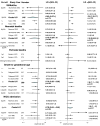Estimation of proteinuria as a predictor of complications of pre-eclampsia: a systematic review
- PMID: 19317889
- PMCID: PMC2670320
- DOI: 10.1186/1741-7015-7-10
Estimation of proteinuria as a predictor of complications of pre-eclampsia: a systematic review
Abstract
Background: Proteinuria is one of the essential criteria for the clinical diagnosis of pre-eclampsia. Increasing levels of proteinuria is considered to be associated with adverse maternal and fetal outcomes. We aim to determine the accuracy with which the amount of proteinuria predicts maternal and fetal complications in women with pre-eclampsia by systematic quantitative review of test accuracy studies.
Methods: We conducted electronic searches in MEDLINE (1951 to 2007), EMBASE (1980 to 2007), the Cochrane Library (2007) and the MEDION database to identify relevant articles and hand-search of selected specialist journals and reference lists of articles. There were no language restrictions for any of these searches. Two reviewers independently selected those articles in which the accuracy of proteinuria estimate was evaluated to predict maternal and fetal complications of pre-eclampsia. Data were extracted on study characteristics, quality and accuracy to construct 2 x 2 tables with maternal and fetal complications as reference standards.
Results: Sixteen primary articles with a total of 6749 women met the selection criteria with levels of proteinuria estimated by urine dipstick, 24-hour urine proteinuria or urine protein:creatinine ratio as a predictor of complications of pre-eclampsia. All 10 studies predicting maternal outcomes showed that proteinuria is a poor predictor of maternal complications in women with pre-eclampsia. Seventeen studies used laboratory analysis and eight studies bedside analysis to assess the accuracy of proteinuria in predicting fetal and neonatal complications. Summary likelihood ratios of positive and negative tests for the threshold level of 5 g/24 h were 2.0 (95% CI 1.5, 2.7) and 0.53 (95% CI 0.27, 1) for stillbirths, 1.5 (95% CI 0.94, 2.4) and 0.73 (95% CI 0.39, 1.4) for neonatal deaths and 1.5 (95% 1, 2) and 0.78 (95% 0.64, 0.95) for Neonatal Intensive Care Unit admission.
Conclusion: Measure of proteinuria is a poor predictor of either maternal or fetal complications in women with pre-eclampsia.
Figures




References
-
- Pollak VE, Nettles JB. The kidney in toxemia of pregnancy: a clinical and pathologic study based on renal biopsies. Medicine (Baltimore) 1960;39:469–526. - PubMed
-
- Spargo B, McCartney CP, Winemiller R. Glomerular capillary endotheliosis in toxemia of pregnancy. Arch Pathol. 1959;68:593–599. - PubMed
-
- Page EW, Christianson R. The impact of mean arterial pressure in the middle trimester on the impact of pregnancy. Am J Obstet Gynecol. 1976;125:740–746. - PubMed
-
- American College of Obstetrics and Gynecology . Practice bulletin No: 33. Washington (DC), American College of Obstetrics and Gynecology; 2002. Diagnosis and management of preeclampsia and eclampsia.
Publication types
MeSH terms
Substances
LinkOut - more resources
Full Text Sources
Other Literature Sources
Medical
Miscellaneous

